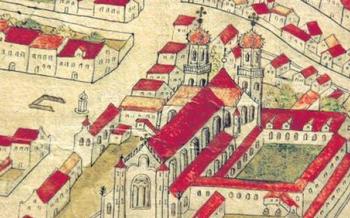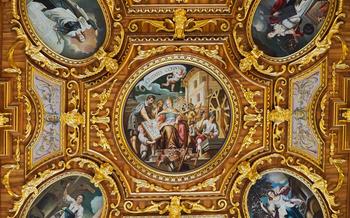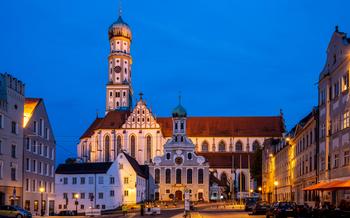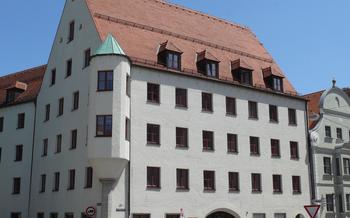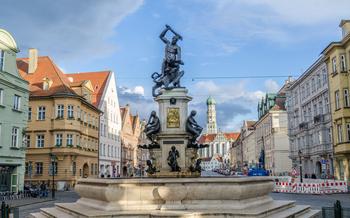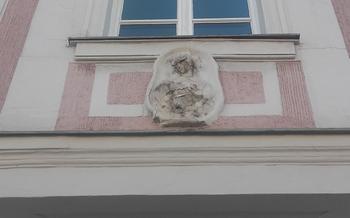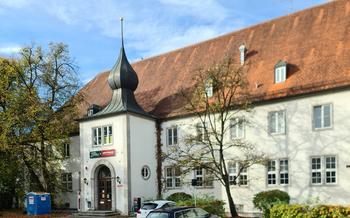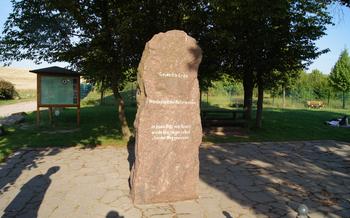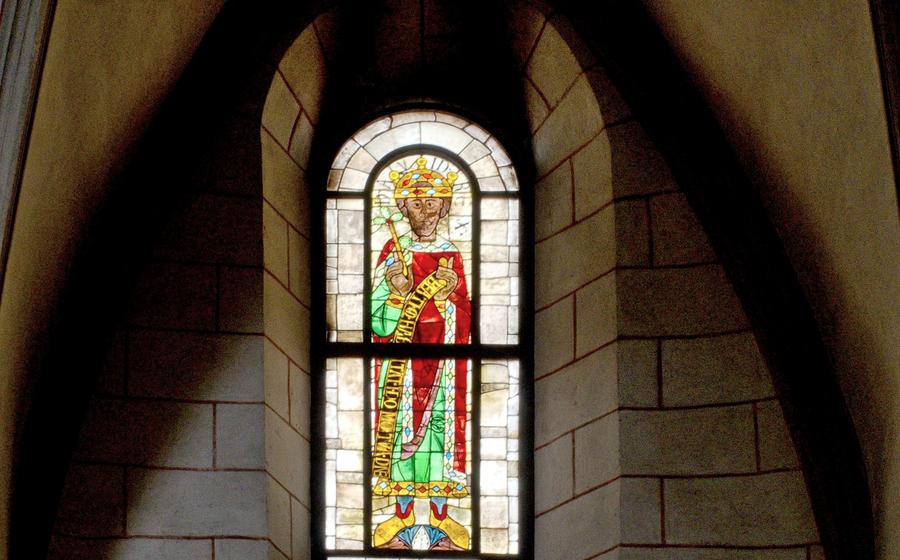
Augsburg Cathedral
- Historical Significance
- Architectural Highlights
- Treasures and Artifacts
- Tours and Services
- Visiting Hours and Admission
- History of the Bishops of Augsburg
- The Domplatz
- The Roman Catholic Diocese of Augsburg
- The Augsburg Cathedral Boys' Choir
- The Legend of St. Ulrich and St. Afra
- Augsburg's Religious Heritage
- Events and Festivals
- Insider Tip:
Historical Significance
Augsburg Cathedral stands as a testament to the city's rich history and its enduring religious and political significance. Founded in the 11th century on the site of an earlier basilica, the cathedral has witnessed centuries of transformation, reflecting Augsburg's evolving role as a center of power and influence. Its Gothic and Romanesque architecture, a blend of grandeur and elegance, speaks to the city's status as a free imperial city and a hub of trade and commerce. The cathedral's towering spires, visible from miles around, symbolize Augsburg's enduring strength and resilience. Throughout its existence, the cathedral has served as a spiritual beacon, a symbol of unity, and a source of pride for the people of Augsburg.
As a center of the Catholic Church in the region, Augsburg Cathedral played a pivotal role in spreading Christianity and shaping the religious landscape of Swabia. Its bishops, wielding considerable influence, were instrumental in fostering religious devotion, promoting education, and contributing to the city's cultural and intellectual development. The cathedral's wealth and prestige attracted numerous pilgrims and visitors, contributing to Augsburg's prosperity and reputation as a thriving center of commerce and culture.
The Reformation, a pivotal moment in European history, brought about significant changes to the cathedral's status and appearance. Augsburg, once a stronghold of Catholicism, embraced the Protestant Reformation, leading to a shift in religious practices and a reconfiguration of the cathedral's interior. The removal of Catholic imagery and the addition of Protestant elements reflected the changing religious landscape of the city. Despite these changes, the cathedral remained a place of worship and a symbol of Augsburg's enduring religious heritage.
Architectural Highlights
Augsburg Cathedral is a stunning example of Gothic and Romanesque architecture, with its towering spires and intricate carvings. The exterior of the cathedral is adorned with numerous sculptures depicting biblical scenes and saints, while the interior features a spacious nave, a grand choir, and elegant transepts.
The cathedral's nave is particularly impressive, with its soaring vaulted ceiling and rows of slender columns. The choir, which is located at the eastern end of the cathedral, is home to the high altar, a magnificent work of art crafted from gold and silver. The transepts, which extend from the nave to the north and south, feature beautiful stained glass windows that depict scenes from the life of Christ.
One of the most striking features of the cathedral is its stained glass windows. These windows, which date from the 13th to the 16th centuries, depict a variety of religious scenes, including the life of Christ, the Virgin Mary, and the saints. The windows are a testament to the skill and artistry of the medieval craftsmen who created them.
The cathedral's ceiling frescoes are another highlight of the interior. These frescoes, which were painted in the 17th century, depict scenes from the Old and New Testaments. The frescoes are a vibrant and colorful addition to the cathedral's interior, and they help to create a sense of awe and wonder.
Treasures and Artifacts
Augsburg Cathedral is home to a trove of valuable treasures and artifacts that hold immense historical and religious significance. Among the most notable is the Golden Madonna, a stunningly crafted statue of the Virgin Mary that dates back to the 13th century. Made of silver-gilt, the statue is adorned with intricate enamel work and precious gemstones, embodying the exceptional artistry and devotion of its creators.
Another treasure of the cathedral is the Augsburg Cross, an exquisite example of medieval metalwork. Created in the 11th century, the cross is made of gold and features intricate carvings that depict scenes from the life of Christ. Its exceptional craftsmanship and historical value make it a prized possession of the cathedral.
Finally, the Reliquary of St. Ulrich is a magnificent shrine that holds the relics of the cathedral's patron saint. Crafted in the 13th century, the reliquary is made of silver and gold and is adorned with precious stones. It is a testament to the enduring veneration of St. Ulrich and the cathedral's role as a center of pilgrimage and devotion.
These treasures, along with numerous other works of art and craftsmanship, contribute to the rich heritage and spiritual significance of Augsburg Cathedral, making it a captivating destination for visitors interested in history, art, and religion.
Tours and Services
Visitors to the Augsburg Cathedral can embark on guided tours to delve deeper into its history, architecture, and treasures. These tours are available in various languages and can be booked in advance to secure a spot. Knowledgeable guides lead the tours, providing insights into the cathedral's construction, its significance in Augsburg's religious and political landscape, and the stories behind the artwork and artifacts it houses.
In addition to guided tours, the cathedral offers a range of services for visitors. Regular religious services, including masses, prayers, and confessions, are held throughout the week, providing an opportunity for spiritual reflection and connection. The cathedral also hosts concerts, exhibitions, and other cultural events, showcasing the talents of local and international artists.
For a more personalized experience, visitors can request private tours tailored to their interests. These tours allow visitors to explore the cathedral at their own pace, ask specific questions, and gain a deeper understanding of its significance.
Practical tips for visitors include dressing respectfully when visiting the cathedral, as it is an active place of worship. Photography is permitted in most areas, but it is important to be mindful of ongoing religious services and events. The cathedral is wheelchair accessible, with ramps and elevators available to ensure that all visitors can fully enjoy their visit.
Visiting Hours and Admission
Visiting Hours:
The Augsburg Cathedral welcomes visitors from all over the world with open arms. Its doors remain open from 10:00 AM to 6:00 PM daily, inviting travelers to explore its grandeur at their convenience. However, it's worth noting that these hours may vary during special occasions or holidays, such as Christmas or Easter. To ensure a hassle-free visit, it's recommended to check the cathedral's official website or contact the local tourist office for the most up-to-date information.
Admission Fees:
Admission to the Augsburg Cathedral is free of charge, allowing everyone to experience its architectural wonders and spiritual atmosphere without financial constraints. This open-door policy reflects the cathedral's commitment to inclusivity and its desire to share its beauty with all who seek it. Visitors are free to wander through the nave, admire the intricate carvings, and soak in the serene ambiance without any additional expenses.
Tips for Avoiding Crowds:
To avoid the hustle and bustle of large crowds, it's advisable to plan your visit accordingly. If possible, try to visit the cathedral during weekdays, as weekends tend to attract more tourists. Early mornings or late afternoons are also ideal times to enjoy a more tranquil experience, allowing you to fully appreciate the cathedral's intricate details without distractions.
History of the Bishops of Augsburg
Throughout history, the Bishops of Augsburg have played a pivotal role in shaping the city's religious and cultural landscape. These influential figures served as spiritual leaders and wielded significant political power, leaving an enduring legacy on the cathedral and the city itself.
One of the most notable bishops was St. Ulrich, who served from 923 to 97He is revered as the patron saint of Augsburg and is credited with defending the city against the Hungarians. His remains are enshrined in the cathedral, making it a popular pilgrimage site.
Another prominent bishop was Heinrich von Knöringen, who held office from 1288 to 130During his tenure, he oversaw the expansion and renovation of the cathedral, transforming it into a magnificent Gothic masterpiece.
In the 16th century, Cardinal Otto Truchsess von Waldburg played a crucial role during the Reformation. As a staunch supporter of Catholicism, he resisted the spread of Protestantism in Augsburg and maintained the city's allegiance to the Catholic Church.
These are just a few examples of the many influential bishops who have graced the Augsburg Cathedral. Their stories and contributions are intertwined with the history of the cathedral and the city, adding to its rich cultural and religious heritage.
The Domplatz
The Domplatz, or Cathedral Square, is the historic square surrounding the Augsburg Cathedral. It is a vibrant and picturesque space that serves as the heart of the city's religious and cultural life. The square is dominated by the imposing presence of the cathedral, but it is also home to several other notable landmarks and architectural gems.
One of the most striking features of the Domplatz is the Perlachturm, a 10th-century watchtower that offers panoramic views of the city. The tower is open to the public and provides a unique perspective on the cathedral and the surrounding area. Another notable landmark is the Augustusbrunnen, a magnificent fountain adorned with sculptures of Roman gods and goddesses. The fountain was erected in 1594 and is a testament to the city's rich history and cultural heritage.
The Domplatz is not just a place of historical significance; it is also a lively and vibrant space that hosts a variety of events and activities throughout the year. The square is often used for markets, festivals, and concerts, which attract both locals and tourists alike. During the Christmas season, the Domplatz transforms into a magical winter wonderland, with festive decorations, twinkling lights, and the scent of mulled wine filling the air.
Whether you are interested in history, architecture, or simply soaking up the atmosphere of a vibrant city, the Domplatz is a must-visit destination in Augsburg. Take some time to explore the square, admire its many architectural treasures, and soak up the unique atmosphere that makes it such a special place.
The Roman Catholic Diocese of Augsburg
The Roman Catholic Diocese of Augsburg, with its roots deeply embedded in the heart of Bavaria, traces its history back to the 4th century. St. Ulrich, the city's patron saint, is credited with establishing the diocese in the year 923 AD. Over the centuries, the diocese has played a pivotal role in shaping the religious and cultural landscape of the region.
The diocese encompasses a vast territory that stretches across the Regierungsbezirk Schwaben, encompassing Augsburg and its surrounding districts. Under the spiritual guidance of its bishops, the diocese diligently serves the spiritual needs of its flock, which numbers over 2 million Catholics.
In recent years, the Diocese of Augsburg has embarked on significant initiatives to strengthen its outreach and engagement with the community. Under the leadership of Bishop Dr. Bertram Meier, the diocese has focused on promoting interfaith dialogue, supporting social welfare programs, and fostering a vibrant youth ministry.
The diocese also takes pride in its rich cultural heritage, which finds expression in its many beautiful churches, monasteries, and other religious institutions. The Augsburg Cathedral, with its awe-inspiring architecture and centuries-old traditions, stands as a symbol of the diocese's enduring legacy.
The Augsburg Cathedral Boys' Choir
The Augsburg Cathedral Boys' Choir, known as the "Augsburger Domsingknaben," is a renowned institution that has been associated with the cathedral for centuries. Its history dates back to the early 14th century, when a choir school was established to train boys in music and liturgy. Over the years, the choir has gained a reputation for its exceptional musical talent and the high quality of its performances.
The selection process for choristers is rigorous, with boys chosen based on their vocal abilities, musical aptitude, and commitment to the choir. Once accepted, the boys receive comprehensive music education and vocal training, which includes learning to sing a wide range of sacred and secular music.
The Augsburg Cathedral Boys' Choir performs regularly at masses and other religious services in the cathedral. They also have a busy concert schedule, performing both in Germany and abroad. The choir has collaborated with renowned orchestras and conductors and has been featured in prestigious music festivals and events.
The Augsburg Cathedral Boys' Choir is not only a musical ensemble but also a community of young singers who share a love of music and a commitment to excellence. The choir has fostered a strong sense of camaraderie and discipline among its members, who often maintain lifelong friendships and memories of their time in the choir.
The Legend of St. Ulrich and St. Afra
Augsburg's religious heritage is deeply intertwined with the lives of two of its patron saints: St. Ulrich and St. Afra. Their captivating legend, passed down through generations, has left an enduring mark on the city's identity.
St. Ulrich, born in the 9th century, was a Benedictine monk who became the Bishop of Augsburg. He was renowned for his piety, wisdom, and unwavering dedication to the people of his diocese. During his lifetime, Augsburg faced numerous challenges, including invasions and famines. St. Ulrich's leadership and prayers are credited with helping the city endure these hardships.
St. Afra, a young woman from Cyprus, arrived in Augsburg during the Roman era. Despite the persecution of Christians at the time, she fearlessly proclaimed her faith. Refusing to renounce her beliefs, she was martyred along with her companions.
The legends surrounding St. Ulrich and St. Afra are filled with miracles and divine interventions. St. Ulrich is said to have miraculously saved the city from a devastating flood by commanding the waters to recede. St. Afra's relics are believed to possess healing powers, attracting pilgrims from far and wide.
The legacy of these two saints lives on in Augsburg. Their relics are enshrined in the Augsburg Cathedral, a testament to their enduring presence in the city's spiritual life. Their stories continue to inspire and guide the faithful, reminding them of the power of faith, courage, and unwavering devotion.
Augsburg's Religious Heritage
Augsburg's religious heritage is deeply intertwined with the history of the Augsburg Cathedral. The city has long been a center of Christianity in the region, and the cathedral has played a pivotal role in shaping its religious identity. Other notable churches and religious sites in Augsburg include St. Ulrich's Basilica, founded in the 9th century and dedicated to the city's patron saint, and the Church of St. Anna, a former Benedictine abbey that now serves as a Protestant church.
Historical events and figures have also played a significant role in shaping Augsburg's religious landscape. The city was a major center of the Reformation, and Martin Luther himself preached in the Augsburg Cathedral in 151The Peace of Augsburg, signed in 1555, established the principle of religious tolerance in the Holy Roman Empire, and Augsburg became a refuge for Protestants fleeing persecution in other parts of Europe.
Today, Augsburg remains a vibrant and diverse religious community. The Roman Catholic Diocese of Augsburg is one of the largest in Germany, and the city is home to a variety of Christian denominations, as well as other faiths. Augsburg's religious heritage is a source of pride for its citizens, and the city's many churches and religious sites continue to play an important role in the lives of its people.
Events and Festivals
The Augsburg Cathedral is not only a historical and architectural marvel but also a vibrant center of religious life. Throughout the year, the cathedral hosts a variety of festivals and events that showcase its spiritual significance and bring the community together. One of the most important events is the Augsburg Cathedral Christmas Market, held annually in the Domplatz. This enchanting market transforms the square into a winter wonderland, complete with twinkling lights, festive stalls, and the irresistible aroma of mulled wine and gingerbread. Visitors can browse unique handmade gifts, indulge in delicious Bavarian treats, and soak up the magical atmosphere of the season.
During the Easter season, the cathedral hosts a series of processions and services that commemorate the crucifixion and resurrection of Jesus Christ. These solemn and moving ceremonies draw large crowds of worshippers and visitors alike. The Corpus Christi procession, held in June, is another major event in the cathedral's calendar. This colorful and elaborate procession sees hundreds of participants carrying ornate floats and banners through the streets of Augsburg, celebrating the Eucharist and the presence of Christ in the world.
These events and festivals offer visitors a unique opportunity to experience the rich religious traditions of Augsburg and witness the cathedral come alive with music, prayer, and celebration.
Insider Tip:
For a truly memorable experience, plan your visit to the Augsburg Cathedral early in the morning or late in the afternoon to avoid the crowds and bask in the ethereal atmosphere of this sacred space. After exploring the cathedral, take a short stroll to the nearby Augustiner Keller, a traditional Bavarian restaurant housed in a former monastery. Indulge in a hearty meal of Schweinshaxe (roasted pork knuckle) or Maultaschen (Swabian ravioli) accompanied by a refreshing Augustiner Bräu beer. This culinary delight will perfectly complement your spiritual journey through the Augsburg Cathedral.
